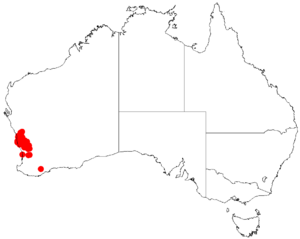Acacia dilatata facts for kids
Acacia dilatata is a special kind of shrub. It's also known as the spreading wattle. This plant belongs to the Acacia family. It grows naturally only in Western Australia. This means it's endemic there.
Quick facts for kids Acacia dilatata |
|
|---|---|
| Scientific classification | |
| Genus: |
Acacia
|
| Species: |
dilatata
|
 |
|
| Occurrence data from AVH | |
What Does the Spreading Wattle Look Like?
This shrub usually grows between 0.3 to 0.7 metres (1 to 2 ft) tall. It has many stems. The plant can grow in a sprawling way or be more compact. Its branches often have tiny hairs. They also have stiff, spiny parts called stipules. These are about 2 to 4 mm (0.079 to 0.157 in) long.
The leaves of this wattle are actually flattened leaf stems. These are called phyllodes. They are dark green to yellow-green. Each phyllode is about 10 to 20 mm (0.39 to 0.79 in) long and 7 to 15 mm (0.28 to 0.59 in) wide.
The spreading wattle blooms from November to February. It produces bright yellow flowers. Its simple flower clusters grow alone in the leaf axils. They are on stalks called peduncles. These stalks are 5 to 10 mm (0.20 to 0.39 in) long. The flower-heads are round or slightly oblong. They hold 15 to 25 golden flowers packed closely together.
After the flowers, dark red-brown seed pods form. These pods are curved and round. They are about 4 to 5.5 mm (0.16 to 0.22 in) wide. They can grow up to 5.5 cm (2.2 in) long. Inside the pods are brown, oblong seeds. These seeds are arranged lengthwise. Each seed can be up to 5.5 mm (0.22 in) long.
Where Does the Spreading Wattle Grow?
The spreading wattle is native to Western Australia. It grows near the west coast. You can find it in the Mid West and Wheatbelt regions. Most of these plants are found from Geraldton in the north. They extend south to Toodyay.
This wattle grows in different types of soil. It likes sandy soils or clay soils. You can find it on sandplains or clay flats. It also grows on rocky areas called lateritic ridges.
Many spreading wattles are scattered from Mingenew south to Mogumber. They often grow in low shrubland areas. They also appear in heath communities. Here, you might see them alongside scattered Eucalyptus and Banksia trees.

